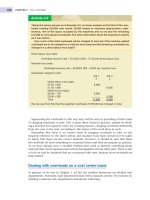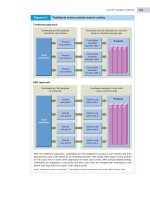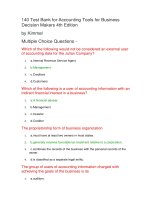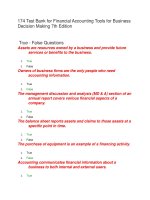Managerial economics economic tools for todays decision makers 7th edtion by keat young and erfle chapter 12
Bạn đang xem bản rút gọn của tài liệu. Xem và tải ngay bản đầy đủ của tài liệu tại đây (229.46 KB, 52 trang )
Chapter 12
Capital Budgeting
and Risk
Outline
•
•
•
•
•
•
•
The capital budgeting decision
Methods of project evaluation
Sources of business risk
Capital budgeting and risk
Sensitivity and scenario analysis
Simulation and decision trees
Real options in capital budgeting
Copyright ©2014 Pearson Education, Inc. All rights reserved.
12-2
Learning Objectives
• Identify the types of capital budgeting decisions
• Calculate net present value and internal rate of return
and distinguish the uses of each measure
• Explain the cost of capital and capital rationing
• Define risk and uncertainty
• Describe and calculate various measures of risk, such
as standard deviation and coefficient of variation
Copyright ©2014 Pearson Education, Inc. All rights reserved.
12-3
Learning Objectives
• Explain the discount rate and certainty equivalents
• Distinguish between sensitivity and scenario
analysis
• Describe how to calculate simulations and decision
trees
• Explain how real options can improve capital
budgeting
Copyright ©2014 Pearson Education, Inc. All rights reserved.
12-4
Capital Budgeting Decision
• Capital budgeting: describes decisions
where expenditures and receipts for a
particular undertaking will continue over a
period of time.
– Capital decisions usually involve outflows of
funds in the early periods while the inflows start
somewhat later and continue for a significant
number of periods
Copyright ©2014 Pearson Education, Inc. All rights reserved.
12-5
Capital Budgeting Decision
• Types of capital budgeting decisions
–
–
–
–
–
–
expansion of facilities
new or improved products
replacement
lease or buy
make or buy
safety or environmental protection equipment
Copyright ©2014 Pearson Education, Inc. All rights reserved.
12-6
Time Value of Money
• Time value of money: a dollar received
today is worth more than a dollar received
tomorrow
• To put cash flows originating at different
times on an equal basis, we must apply an
interest rate to each of the flows so that
they are expressed in terms of the same
point in time.
Copyright ©2014 Pearson Education, Inc. All rights reserved.
12-7
Methods of Capital
Project Evaluation
• Payback: time period (years) necessary to
recover the original investment (may be
non-discounted dollars)
• Accounting rate of return: percentage
resulting from dividing average annual
profits by average investment
Copyright ©2014 Pearson Education, Inc. All rights reserved.
12-8
Methods of Capital
Project Evaluation
Methods that discount cash flows to a
present value
– net present value (NPV)
– internal rate of return (IRR)
– profitability index (PI)
Copyright ©2014 Pearson Education, Inc. All rights reserved.
12-9
Methods of Capital
Project Evaluation
• Net Present Value formula
n
n
Rt
Ot
NPV
t
t
t 1 1 k
t 0 1 k
t = time period
n = last period of project
Rt = cash inflow in period t
Ot = cash outflow in period t
k = discount rate (cost of capital)
Copyright ©2014 Pearson Education, Inc. All rights reserved.
12-10
Methods of Capital
Project Evaluation
• If NPV is positive, the project is financially
acceptable. If it is negative, rejection is
indicated.
• Discount rate (k): The discount rate, k, is
the interest rate used to evaluate the
project. This rate represents the cost of the
funds employed (the opportunity cost of
capital).
Copyright ©2014 Pearson Education, Inc. All rights reserved.
12-11
Methods of Capital
Project Evaluation
The internal rate of return of a project is
the discount rate that causes NPV to equal
zero. Formula:
n
n
Rt
Ot
t
t
(
1
r
)
(
1
r
)
t 1
t 0
If the IRR is larger than the cost of capital it
signals acceptance. If the IRR is less than the
cost of capital the proposed project should be
rejected.
Copyright ©2014 Pearson Education, Inc. All rights reserved.
12-12
Methods of Capital
Project Evaluation
• For single projects IRR and NPV will give the
same results:
– NPV > 0, IRR > k
– NPV = 0, IRR = k
– NPV < 0, IRR < k
Copyright ©2014 Pearson Education, Inc. All rights reserved.
12-13
Methods of Capital
Project Evaluation
• If multiple projects are being considered, IRR
and NPV will give the same results if the
projects are independent.
– projects can be implemented simultaneously
– one project will not affect the cash flow of
another
Copyright ©2014 Pearson Education, Inc. All rights reserved.
12-14
Methods of Capital
Project Evaluation
• IRR and NPV methods may yield different
results if mutually exclusive projects are
analyzed and if:
– the initial costs of the proposals differ
– the shapes of the cash inflow streams differ
A problem with IRR is uneven cash flows.
NPV is the recommended measure of a project
value to the firm.
Copyright ©2014 Pearson Education, Inc. All rights reserved.
12-15
Methods of Capital
Project Evaluation
• Profitability index
PI = (PV of cash flows)/(Initial investment)
• The project will be financially acceptable if PI
is greater than 1 and not acceptable if PI is
less than 1.
Copyright ©2014 Pearson Education, Inc. All rights reserved.
12-16
Methods of Capital
Project Evaluation
• In most cases, NPV and IRR calculations will
lead to the same capital budgeting decision.
If they are in conflict, NPV is the
theoretically more correct measure.
– The financial objective of the firm is the
maximization of stockholder wealth, which is
what NPV measures.
– The NPV reinvestment assumption, at k, appears
to be more realistic.
Copyright ©2014 Pearson Education, Inc. All rights reserved.
12-17
Cash Flows
• The analyst’s most difficult task is to enter
the best estimates of cash flows into the
analysis.
– future timing and amount of cash flows are
uncertain
– data from organizational entities have to be
examined for potential bias
• market forecasts may be biased upward
• costs are often underestimated
Copyright ©2014 Pearson Education, Inc. All rights reserved.
12-18
Cash Flows
• Guidelines for analyzing cash flows:
– all revenue and costs must be stated in terms of
cash flows
– all cash flows should be incremental
– sunk costs do not count
– any effect on other parts of the operation must
be taken into account
– interest paid on debt is not considered
Copyright ©2014 Pearson Education, Inc. All rights reserved.
12-19
Cash Flows
• Types of cash flows
– Initial cash outflows: payments that occur at the
inception of the project
– Operating cash flows: revenues, costs, and
expenses generated by the project
– Additional working capital: inventories, accounts
receivable, cash needed for growth that are
recovered at the end of the project
Copyright ©2014 Pearson Education, Inc. All rights reserved.
12-20
Cash Flows
• Types of cash flows
– Salvage or resale values: expected sales value of
project machinery at end of project
– Noncash investment: use of an existing machine
that is not used
Copyright ©2014 Pearson Education, Inc. All rights reserved.
12-21
Cost of Capital
• Debt finance
– short-term
– long-term
• Equity finance
– new equity
– retained earnings
Copyright ©2014 Pearson Education, Inc. All rights reserved.
12-22
Cost of Capital
Cost of debt = r · (1 – t)
r = present interest rate charged for the kind
of debt the company would issue
t = tax rate (interest expense is tax
deductible)
Copyright ©2014 Pearson Education, Inc. All rights reserved.
12-23
Cost of Capital
Equity: retained earnings
D1
ke g
P0
ke = cost of equity capital
D1 = dividend, next period
P0 = current stock price
g = rate at which dividend is expected to
grow
Copyright ©2014 Pearson Education, Inc. All rights reserved.
12-24
Cost of Capital
• Equity: new raisings
D1
ke
g
P0 (1 f )
ke = cost of equity capital
D1 = dividend, next period
P0 = current stock price
g = rate at which dividend is expected to grow
f = flotation costs (as % of P0)
Copyright ©2014 Pearson Education, Inc. All rights reserved.
12-25









